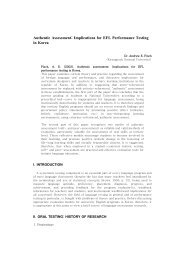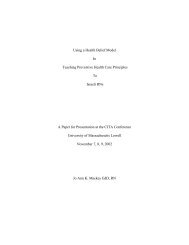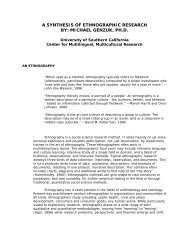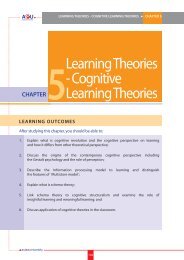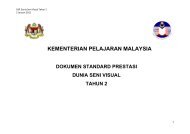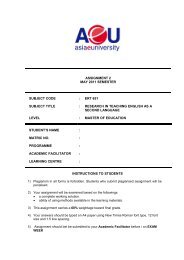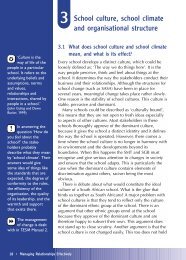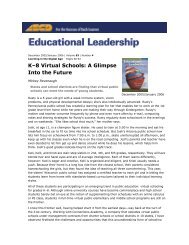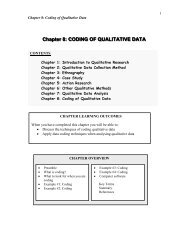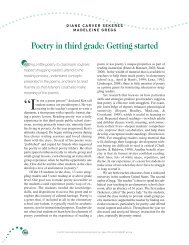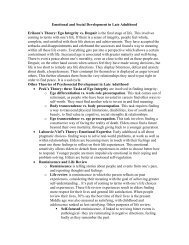a communicative approach to teaching grammar - Malaysian ...
a communicative approach to teaching grammar - Malaysian ...
a communicative approach to teaching grammar - Malaysian ...
Create successful ePaper yourself
Turn your PDF publications into a flip-book with our unique Google optimized e-Paper software.
The English The English Teacher Teacher Vol. XXXIV, Vol.XXXIV 33-50<br />
A COMMUNICATIVE APPROACH TO TEACHING GRAMMAR:<br />
THEORY AND PRACTICE 1<br />
Siaw-Fong Chung<br />
National Taiwan University<br />
ABSTRACT<br />
Since the introduction of Communicative Language Teaching (CLT), many textbooks<br />
have been written <strong>to</strong> incorporate <strong>communicative</strong> activities, authentic materials and<br />
personalized contexts. However, where the <strong>teaching</strong> and learning of <strong>grammar</strong> is concerned,<br />
most textbooks do not reflect CLT principles. As demonstrated in this paper, <strong>grammar</strong><br />
activities in some <strong>Malaysian</strong> and Taiwanese textbooks retain the structural method of<br />
<strong>teaching</strong> <strong>grammar</strong>. This paper suggests five methods so that <strong>grammar</strong> activities can be<br />
made more <strong>communicative</strong> by retaining some practices of the structural syllabus.<br />
Introduction<br />
Communicative Language Teaching (CLT) materialized in the West in the 1960s<br />
and has extended <strong>to</strong> the Eastern countries over the last 20 years. Since then, CLT<br />
principles have formed the foundation of English language syllabi for countries<br />
such as Malaysia and Taiwan. In Malaysia, CLT was adopted as early as the 1970s<br />
but in Taiwan, the switch from the structural <strong>to</strong> <strong>communicative</strong> <strong>approach</strong> only started<br />
in the 1990s. Before CLT was introduced, the structural syllabus was the mainstream<br />
<strong>approach</strong> in most Asian settings including Malaysia and Taiwan. Yalden (1987:61)<br />
summarized the essence of CLT thus:<br />
It is based on the notion of the learners as communica<strong>to</strong>rs, naturally endowed with<br />
the ability <strong>to</strong> learn languages. It seeks <strong>to</strong> provide learners with the target language<br />
system. It is assumed that learners will have <strong>to</strong> prepare <strong>to</strong> use the target language<br />
(orally and in written form) in many predictable and unpredictable acts of<br />
communication which arise both in classroom interaction and in real-world<br />
situations, whether concurrent with language training or subsequent <strong>to</strong> it.<br />
1<br />
I would like <strong>to</strong> thank John Kullman of Canterbury Christ Church University College, Canterbury,<br />
England, for his comments on the previous version of this paper. My appreciation also goes <strong>to</strong><br />
Professor Kathleen Ahrens of National Taiwan University and the reviewer(s) of the English Teacher<br />
for reading and commenting on this paper. Any remaining errors are my sole responsibility.<br />
33
The English Teacher Vol.XXXIV<br />
After CLT was implemented, many English textbooks were designed attempting<br />
<strong>to</strong> accommodate the expectations of the <strong>communicative</strong> syllabus. When <strong>grammar</strong><br />
<strong>teaching</strong> is concerned, CLT focuses on “<strong>communicative</strong> proficiency rather than mere<br />
mastery of structures” (Richards and Rogers, 1986:64). However, how well<br />
<strong>communicative</strong> proficiency can replace the structural <strong>approach</strong> is a question that<br />
many ELT practitioners are interested in. Considering the influence of the structural<br />
practice which is deep-rooted in the Asian culture, it will be a debatable issue as <strong>to</strong><br />
how CLT comes in<strong>to</strong> play in the Asian classrooms.<br />
In the following sections, the components of the structural and <strong>communicative</strong><br />
<strong>approach</strong>es are first outlined. In order <strong>to</strong> find out whether CLT principles are<br />
incorporated in<strong>to</strong> <strong>grammar</strong> exercises in textbooks, this paper then analyses several<br />
<strong>grammar</strong> activities from <strong>Malaysian</strong> and Taiwanese textbooks and reports related<br />
findings. Finally, five activities based on CLT are recommended.<br />
Structural and Communicative Syllabi<br />
The structural view of language sees grammatical structures as the underlying units<br />
of the language system. These units of language are structurally rule-governed. The<br />
audiolingual syllabus 2 is also derived from the structural view and it was practiced<br />
in Taiwan and Malaysia before the implementation of the CLT. This syllabus comprises<br />
activities that focus on correct pronunciation, spelling convention and grammatical<br />
forms. Drills are also used in the audiolingual classroom because repetition and<br />
memorisation are believed <strong>to</strong> be important. However, the CLT syllabus has redefined<br />
the <strong>teaching</strong> of <strong>grammar</strong>, teachers’ and students’ roles, use of materials and <strong>teaching</strong>learning<br />
methodology. Finocchiaro and Brumfit (1983) describe the CLT syllabus as<br />
follows:<br />
1. a. Meaning (function) is emphasised<br />
b. Contextualisation is important<br />
c. Language learning is learning <strong>to</strong> communicate<br />
d. Language is created through repeated trials and errors<br />
e. Fluency is primary whereas accuracy is secondary.<br />
2<br />
Also referred as ‘Audiolingual Method.’ Some also refer <strong>to</strong> the ‘Communicative Syllabus’ as the<br />
‘Communicative Approach’ (Richards and Rogers, 1986). This paper terms both as ‘syllabi’ because<br />
it is the course outlines that are referred <strong>to</strong> in this paper.<br />
34
The English Teacher Vol.XXXIV<br />
In addition <strong>to</strong> these features, CLT also emphasizes learner-centeredness and the<br />
use of original materials. Howatt (1984) divided CLT in<strong>to</strong> strong and weak versions.<br />
The strong version is in support of <strong>communicative</strong> features whereas the weak version<br />
suggests the integration of structural practice in<strong>to</strong> the <strong>communicative</strong> elements.<br />
This paper is of the view that both structural and <strong>communicative</strong> elements have<br />
a role <strong>to</strong> play in EFL and ESL especially in the Asian setting. This is due <strong>to</strong> two main<br />
reasons: First, the norms and practices of the structural syllabus have been embedded<br />
in the Asian cultures for decades. For instance, in a survey carried out by Maley<br />
(1986:104) on the Chinese of Mainland China, it was found that the Chinese view<br />
the teacher as the “textbook” or the guru that “has the knowledge.” Therefore, <strong>to</strong><br />
learn is <strong>to</strong> convert knowledge in the textbooks <strong>to</strong> memory. This belief is adopted<br />
even in <strong>to</strong>day’s Taiwanese society (despite some efforts <strong>to</strong> move <strong>to</strong>ward CLT).<br />
Second, <strong>communicative</strong> proficiency will become easier <strong>to</strong> achieve only when<br />
one has grasped the necessary knowledge of language (such as <strong>grammar</strong>). For societies<br />
whose first (and second) language is not English, there is still a need for structural<br />
practices so that the foundation of linguistic knowledge can be built up before further<br />
<strong>communicative</strong> tasks are given. Yalden (1987:94) suggests the proportional <strong>approach</strong><br />
in course designing. In this design, students learn more form than meaning at an<br />
early stage and as time increases (and as students’ language proficiency improves),<br />
the intervention of <strong>communicative</strong> functions increases. At this later stage, the emphasis<br />
on form can be gradually reduced.<br />
In order <strong>to</strong> examine whether the textbooks comply with either the structural or<br />
the <strong>communicative</strong> syllabus, the next section will take examples from the <strong>Malaysian</strong><br />
and the Taiwanese textbooks. The reason for selecting these two countries is that<br />
both have strong practices of the audiolingual syllabus in their language learning<br />
his<strong>to</strong>ry. Despite this similarity, the more interesting question is how CLT is received<br />
in these two countries when their English positions differ (English is a second language<br />
in Malaysia but a foreign language in Taiwan) and when one English dialect is used<br />
instead of another (Malaysia uses British English while Taiwan uses American<br />
English). This paper compares <strong>grammar</strong> activities in the textbook in these two<br />
countries because <strong>grammar</strong> is the hardest component <strong>to</strong> teach with CLT <strong>approach</strong>.<br />
Comparison of <strong>Malaysian</strong> and Taiwanese English Textbooks<br />
In this section, excerpts of <strong>grammar</strong> activities are taken from textbooks so that<br />
comparisons can be made regarding the treatment of <strong>grammar</strong> in the <strong>Malaysian</strong> and<br />
Taiwanese contexts.<br />
35
The English Teacher Vol.XXXIV<br />
<strong>Malaysian</strong> Textbooks<br />
The <strong>Malaysian</strong> English language syllabus is outlined by the Curriculum Development<br />
Centre (CDC) of Malaysia. The attempt <strong>to</strong> incorporate <strong>communicative</strong> language<br />
<strong>teaching</strong> can be seen in the aims of the Form Four English Language Syllabus which<br />
emphasises daily <strong>communicative</strong> needs and occupational needs:<br />
To equip them [students] with the skills and knowledge of the English language <strong>to</strong><br />
communicate in certain everyday activities and certain job situations, and also <strong>to</strong><br />
provide points of take-off for various post-secondary school needs… (Ministry of<br />
Education, 1992:1)<br />
However, when <strong>grammar</strong> is presented in textbooks, it usually does not reflect<br />
the aim of the <strong>communicative</strong> syllabus. An analysis of the KBSM English Form<br />
Four (Noor Azlina Yunus and Angeline Spykerman, 1996) shows that most of the<br />
<strong>grammar</strong> activities still feature the traditional pattern rather than conforming <strong>to</strong> the<br />
principles of the <strong>communicative</strong> syllabus. Even though some parts of the textbooks<br />
attempt <strong>to</strong> integrate the <strong>communicative</strong> elements, most exercises are mainly structural<br />
with the inclusion of <strong>grammar</strong>-rule explanation, as shown in Table 1 below 3 .<br />
Table 1: Grammar Exercise taken from Noor Azlina Yunus and Angeline Spykerman<br />
(1996:211-212)<br />
We form the passive of perfect tenses with have/has been + past participle and had been +<br />
past participle.]<br />
Present perfect tense<br />
Subject Verb Object ‘Doer’ or Agent<br />
Active Professor Kazan has trained the dolphins <strong>to</strong> speak English.<br />
Passive The dolphins have been trained <strong>to</strong> speak English by Professor Kazan .<br />
Past Perfect Tense<br />
Active Professor Kazan had trained the dolphins since birth.<br />
Passive The dolphins had been trained since birth by Professor Kazan.<br />
We can leave out the ‘doer’ or agent if it is obvious who the person is.<br />
9. Write the newspaper headlines as sentences using the passive from of the present<br />
perfect tense.<br />
1. Thousands of books damaged in warehouse fire<br />
2. Valuable Koran S<strong>to</strong>len from Museum<br />
3. Cost of Imported Books Criticised by Public<br />
3<br />
All textbook excerpts in this paper are re-typed by the author. None of these excerpts are taken from<br />
one complete page of the textbooks.<br />
36
The English Teacher Vol.XXXIV<br />
The first row in Table 1 is the explanation of the <strong>grammar</strong> rule. The second and<br />
third rows show the decomposed components of the perfect tenses. The decomposition<br />
of sentences in<strong>to</strong> subject, object, verb and agent is the common method employed<br />
by the structural syllabus. The last row shows an attempt <strong>to</strong> incorporate authentic<br />
material (i.e., newspaper headlines) in<strong>to</strong> the <strong>grammar</strong> exercise. Other than this, the<br />
general pattern is transformational, i.e., <strong>to</strong> show how sentences are converted from<br />
one form <strong>to</strong> another.<br />
In the other sections of this textbook, <strong>communicative</strong> activities are selectively<br />
placed in different sections of the chapters. In the chapter from which the above<br />
example is extracted, there are attempts <strong>to</strong> link the theme Book Report <strong>to</strong> the contents<br />
of the chapter (with insertion of novel readings). This makes the context of the reading<br />
task <strong>communicative</strong>. In addition, there is also speaking practice placed as pre-reading<br />
activity in which students have <strong>to</strong> work in groups <strong>to</strong> come up with a book list.<br />
Nevertheless, where <strong>grammar</strong> is concerned, the context used (‘training dolphins’<br />
in Table 1) is not immediately related <strong>to</strong> the theme of the chapter. This alternation of<br />
<strong>communicative</strong> and traditional activities is reflected throughout the textbook.<br />
Traditional practice patterns such as sentence transformation (as in Table 1) and<br />
substitution tables (see Table 2) are seen in this textbook.<br />
Table 2:<br />
Substitution table on present perfect tense (Noor Azlina Yunus and Angeline<br />
Spykerman, 1996:97)<br />
There has been a sharp rise/increase in•<br />
gradual<br />
fall/decrease/dip<br />
slight<br />
(The price) has risen/increased/gone up sharply since •<br />
(Numbers) have fallen/decreased/dipped gradually between • and •<br />
slowly<br />
during •<br />
[• <strong>to</strong> be filled with information from a chart]<br />
Similar <strong>to</strong> the transformational exercise, a substitution table decomposes<br />
sentences in<strong>to</strong> parts of speech. The way sentences are broken down in<strong>to</strong> their<br />
grammatical units is also part of the methodology of the structural syllabus.<br />
To verify the observation regarding the <strong>grammar</strong> exercises, two other textbooks<br />
are examined for similar purposes. These textbooks are English Form 4 (Lee, Roberts<br />
and Chew, 2002) and English Form 5 (Lee, Roberts and Chew, 2003). In English<br />
37
The English Teacher Vol.XXXIV<br />
Form 4 by Lee et al. (2002:41-43), the present perfect was presented as in (2)<br />
below:<br />
2. Explanation of rules for present perfect tense<br />
Transformational exercise (from use a computer <strong>to</strong> I have used a computer<br />
since Form 1)<br />
Revision of simple present and simple past tense<br />
Exercise for present perfect, simple present and past tense (gap filling)<br />
The presentation of activities in this textbook is similar <strong>to</strong> that in Noor Azlina<br />
Yunus and Angeline Spykerman (1996), i.e., rules are presented before the exercise.<br />
This textbook has integrated grammatical forms by providing revision and combined<br />
exercises after introducing the present perfect tense.<br />
Compared <strong>to</strong> English Form 4 by Lee et al., the present perfect tense in English<br />
Form 5 (by the same writers) shows an increase in difficulty in terms of the explanation<br />
of rules. The Form Five textbook starts with a short paragraph containing examples<br />
of the present perfect tense, followed by an explanation of <strong>grammar</strong> rules. The order<br />
of presentation is shown in (3) below (Lee et al. 2003:91-92).<br />
3. Short paragraph containing the present tense<br />
Explanation of rules (with the decomposition of the perfect tense and an emphasis<br />
on time line) (see Table 3)<br />
Gap filling activity<br />
Sentence completion activity (in an interview between a reporter and an<br />
interviewee)<br />
Therefore, one can see that the Form Five textbook is still rule-based and the<br />
expectation for linguistic awareness is higher. This can be seen in the illustration in<br />
Table 3 (reproduced from the figures in Lee et al. 2003:91).<br />
In Table 3, the reason for using the present perfect tense is explained, which is a<br />
more advanced way of explaining the grammatical form than by giving the<br />
decomposed elements of has/have + past participle, as in the Form Four textbook.<br />
This Form Five textbook also provides a <strong>communicative</strong> context (the interview) for<br />
the use of the perfect tense.<br />
38
The English Teacher Vol.XXXIV<br />
Table 3: Excerpt of explanation from English Form 5 (Lee et al., 2003:91)<br />
We use the present perfect tense <strong>to</strong> talk about an action in the past which has a result<br />
in the present. The following diagram illustrates this:<br />
PAST<br />
The helicopters<br />
arrived.<br />
PRESENT<br />
(time of speaking)<br />
Result: The helicopters are here now.<br />
To refer <strong>to</strong> this past event which has a result in the present, we say:<br />
The helicopters have arrived.<br />
present perfect<br />
Here is another example<br />
PAST<br />
Pollution from the oil spill<br />
damaged the coral reef.<br />
PRESENT<br />
(time of speaking)<br />
Result: The coral reef is damaged.<br />
To refer <strong>to</strong> this event in the past, we say:<br />
Pollution from the oil spill has damaged the coral reef.<br />
present perfect<br />
In general, all three <strong>Malaysian</strong> textbooks examined in this paper show that<br />
traditional <strong>teaching</strong> practice is still reflected in the design of <strong>grammar</strong> activities. The<br />
next section will investigate whether this is also the case in the Taiwanese textbooks.<br />
39
The English Teacher Vol.XXXIV<br />
Taiwanese Textbooks<br />
An examination of the Taiwanese senior high school English textbooks (Senior High<br />
School English (1999, Books One and Two) shows the following features:<br />
a. Both books One and Two provide translation in Chinese, a characteristic that is<br />
not found in <strong>Malaysian</strong> English textbooks. Below is an example of the list of<br />
vocabulary items from the Senior High School English Book 1 (1999:128).<br />
b. Both books One and Two place high priority on vocabulary. The overt emphasis<br />
on the vocabulary items is not the feature of CLT as it may interfere with the<br />
natural flow of communication.<br />
c. Both books attempt <strong>to</strong> include <strong>communicative</strong> or creative activities at the end of<br />
every chapter.<br />
Table 4 shows an example of a <strong>grammar</strong> activity from this textbook. The example<br />
in Table 4 first gives the construction of the target sentence written in the form of<br />
“…N which + V…(which = N).” Then several examples are given so that students<br />
know what the construction is like. Lastly, students are asked <strong>to</strong> form their own<br />
sentences. This example reflects a typical structural practice in <strong>grammar</strong> <strong>teaching</strong>.<br />
Similar <strong>to</strong> the <strong>Malaysian</strong> textbooks, the <strong>communicative</strong> part comes in through the<br />
use of real life contexts (such as the life of Paul Newman and life in Harvard<br />
University in the Taiwanese textbook (Book 2)). However, the <strong>grammar</strong> exercises<br />
are largely structurure-based. In order words, the implementation of CLT has only<br />
impacted the ‘contextualisation’ of content but not the <strong>teaching</strong> of <strong>grammar</strong>.<br />
In order <strong>to</strong> verify whether grammatical exercises receive similar treatment in<br />
other Taiwanese textbooks, two other textbooks were examined. These textbooks<br />
are Far East English Reader for Senior High Schools (Shih, Lins and Brooks, 1999,<br />
Volumes One and Three). Both these volumes provide a vocabulary list in English<br />
and Chinese. All chapters are organised according <strong>to</strong> a theme, as in the <strong>Malaysian</strong><br />
textbooks.<br />
40
The English Teacher Vol.XXXIV<br />
Table 4: Grammar Exercise taken from the Senior High School English Book 2. (1999:87)<br />
C. …N which + V…(which = N)<br />
Examples:<br />
Jim works for a company.<br />
The Company makes computer.<br />
Jim works for a company which makes computers.<br />
A dictionary is a book.<br />
The book gives us meanings of words.<br />
A dictionary is a book which gives us the<br />
meanings of words.<br />
Combine the following pairs of sentences by using the structure given above:<br />
1. I am reading the novel.<br />
{<br />
{<br />
{<br />
You lent me the novel last week.<br />
2. The answer is right.<br />
You <strong>to</strong>ld me the answer.<br />
{<br />
Chapter 9 of Volume One (one of the chapters that teaches the perfect tense)<br />
starts with the past continuous tense, followed by the past perfect tense. This paper<br />
will focus on the section with past perfect tense only. The order of presentation is as<br />
in (4) below.<br />
(4) Substitution table and examples with short context<br />
Practice (Read the situations and finish the last sentence using the past perfect)<br />
As shown in (4), there are only two sub-sections for the perfect tenses. An example<br />
of the practice section is shown in (5) below (Shih et al., 1999:141).<br />
(5) 1. The airplane <strong>to</strong>ok off at 9:10.<br />
Sarah arrived at the airport at 10:00.<br />
When Sarah arrived at the airport, the airplane had taken off. [answer<br />
given in textbook]<br />
41
The English Teacher Vol.XXXIV<br />
Although the <strong>grammar</strong> section starts with a substitution table which shows the<br />
decomposed sentence containing the past perfect tense, the practice exercise shows<br />
some level of contextualisation. This helps students relate the use of language <strong>to</strong><br />
their immediate surroundings. However, as mentioned earlier, the <strong>communicative</strong><br />
activities usually come after the explanation of rules.<br />
Comparatively, Chapter 11 of Volume 3 (which is a more advanced level) begins<br />
with the past perfect tense with examples, as shown in (6) below (Shih et al.,<br />
1999:175).<br />
(6) Examples:<br />
• Foyot’s was such an expensive restaurant that I had never thought of going<br />
there.<br />
• The prices were much higher than I had expected.<br />
Only these two examples are given. The practice section comprises two tasks.<br />
The first task requires the student <strong>to</strong> complete a passage using the past tense or the<br />
past perfect tense. Two are shown in (7) below (Shih et al., 1999:176)<br />
(7) 1. Actually I didn’t want <strong>to</strong> see that movie because I _____________ (see) it<br />
before.<br />
2. Still I ______ (go) <strong>to</strong> the movie with Jenny because I _______ (promise)<br />
her I would last week.<br />
From the examples in (7) (as well as other examples earlier), one can see that<br />
there is an emphasis on accuracy and not on communication. As for the second task,<br />
more contextualised use of the past perfect tense is allowed. The following are<br />
instructions for this task (Shih et al., 1999:177):<br />
Bill is twenty years old. His family loves <strong>to</strong> travel. Hence, he has had some<br />
experiences that many young people of his age have not had. That’s why he likes <strong>to</strong><br />
share his adventures with his friends. Look at the chart below and complete Bill’s<br />
statements.<br />
The chart shows a time line of Bill’s age and the activities he <strong>to</strong>ok part in at a<br />
particular age. For instance, before age 6, there are the phrases that say saw the<br />
Statue of Liberty and visited the pyramids in Egypt. Then, the students are asked <strong>to</strong><br />
fill in sentences such as those in (8).<br />
42
The English Teacher Vol.XXXIV<br />
(8) 1. By the time I went <strong>to</strong> senior high school, I had been <strong>to</strong> many different<br />
places. [answer given in textbook]<br />
2. By the time I was six, I ______________.<br />
In this volume, although there is an attempt <strong>to</strong> make the exercise more<br />
<strong>communicative</strong> by providing the context of Bill’s activities, the <strong>communicative</strong>ness<br />
of the context is not further pursued in the <strong>grammar</strong> exercise (cf. (8)).<br />
Based on these exercises, the conclusion regarding the Taiwanese textbooks is<br />
that they are still structurure-based, with emphasis on accuracy rather than fluency.<br />
To summarize this section, Table 5 below displays some of the similarities and<br />
differences between the <strong>Malaysian</strong> and Taiwanese English textbooks.<br />
Table 5: Comparison of English Textbooks in <strong>Malaysian</strong> and Taiwan<br />
<strong>Malaysian</strong> Textbooks<br />
Taiwanese Textbooks<br />
1. No translation in<strong>to</strong> mother <strong>to</strong>ngue. Vocabulary items are translated in<strong>to</strong> Chinese.<br />
2. A subject or theme for each unit. A subject or theme for each chapter. Topics<br />
contain American influence.<br />
3. Grammar is largely structural and in Grammar is structural and focuses on the usage<br />
isolation. Language points consist of particular <strong>grammar</strong> structure such as ‘It’s<br />
of the conventional tenses, articles, time for....’ and the use of relative ‘which’<br />
proverbs, etc.<br />
4. Materials are modified passages Materials are modified passages<br />
Based on Table 5, the treatment of <strong>grammar</strong> in both textbooks is not based on<br />
CLT principles. In a study on Taiwanese and Japanese English textbooks Huang<br />
(1999), found that both the audiolingual and <strong>communicative</strong> <strong>approach</strong>es are present<br />
in the junior-high English curriculum. This is also evident in the comparison of<br />
<strong>grammar</strong> activities in this paper. This shows that the structural pattern of <strong>grammar</strong><br />
practice is retained, and that <strong>grammar</strong> <strong>teaching</strong> in Asian settings is less impacted by<br />
the implementation of CLT in comparison <strong>to</strong> other areas.<br />
Incorporating Communicative Tasks<br />
This section addresses the question of how CLT can be implemented in Asian<br />
classrooms, whilst taking in<strong>to</strong> account students’ needs and interests as well as their<br />
language background. This paper is of the view that both meaning and form can be<br />
43
The English Teacher Vol.XXXIV<br />
emphasised at different stages of the activities, a reflection of Yalden’s (1987)<br />
proportional <strong>approach</strong> <strong>to</strong> course designing. This view is also supported by Wu (1998),<br />
who suggests that structural activities in textbooks need <strong>to</strong> be supplemented by<br />
<strong>communicative</strong> activities. Five activities are suggested: games, natural contexts,<br />
activities that balance skills, personalisation, and adjustment of teacher role.<br />
I. Games<br />
The notion of using games in the <strong>communicative</strong> classroom is not new <strong>to</strong> ESL and<br />
EFL teachers. Still, there are different attitudes <strong>to</strong>wards the role of games in a<br />
classroom. Although a negative view tends <strong>to</strong> treat games as time-fillers or timewasters<br />
(Rixon, 1981:1), they can make a lesson more relaxed and memorable. In a<br />
survey on Taiwanese Junior High School English by Cheng (1998), students<br />
nominated games and contests <strong>to</strong> be their most favorite activities, followed by singing<br />
and group discussions. This indicates that the use of games is one of the ways <strong>to</strong><br />
attract students’ interests in learning.<br />
To use games in the classroom, Rixon (1981:1) suggests three key principles: a)<br />
think about games; b) know their ingredients and c) know how <strong>to</strong> vary them. Figure<br />
1 shows the application of these principles <strong>to</strong> teach the perfect tenses.<br />
In this activity, teachers set the rules (the players, the penalties, etc.). The<br />
ingredients in the preparation of this game are an empty track (the continuous squares),<br />
targeted sentences, dices and moving chips. Figure 1 takes the tracks as in the game<br />
Monopoly. Another example of tracks comes from the Snakes and Ladders game<br />
(continuous squares that are arranged in zigzag format from <strong>to</strong>p <strong>to</strong> bot<strong>to</strong>m). These<br />
‘templates’ of tracks can be saved in the computer and retrieved whenever needed.<br />
Teachers can change the sentences in the squares according <strong>to</strong> lesson objectives. For<br />
example, <strong>to</strong> practice It’s time (for somebody) <strong>to</strong> V (Verb) (Senior High School English,<br />
Book 2. 1999:23), teachers can place cue words such as mother and cook in a square<br />
and brother and go home in another. Teachers can also teach according <strong>to</strong> students’<br />
proficiency levels by manipulating this basic knowledge of games.<br />
The activity shown in Figure 1 focuses both on form and meaning. It suggests<br />
supplementation <strong>to</strong> the traditional exercises found in the Asian textbooks. When<br />
playing the game, students practice forms unconsciously by way of communication.<br />
A successful <strong>communicative</strong> activity helps <strong>to</strong> generate the target language<br />
unconsciously but at the same time makes students enjoy what they are doing.<br />
44
The English Teacher Vol.XXXIV<br />
11. BONUS! 10. Go Back 9. The idea of 8. Everybody 7. Mr. Lee of my<br />
Get an extra Three Squares! using e-mails (get) used school (object)<br />
turn! for submitting <strong>to</strong> using <strong>to</strong> this idea<br />
homework textbooks since it has<br />
(worry) many for <strong>teaching</strong>, been<br />
teachers. but not introduced.<br />
computers.<br />
12. I (never 6. My friend<br />
think) of<br />
(improve) in<br />
studying<br />
her computer<br />
computer but<br />
knowledge.<br />
now I am<br />
forced <strong>to</strong>.<br />
13. My mum 5. I (learn)<br />
(never hear)<br />
how <strong>to</strong> use<br />
about CD-Rom.<br />
CD-Rom<br />
before.<br />
FINISH 1. Teaching 2. My school 3. The 4. I (have)<br />
using (buy) 20 government computer<br />
computers computers (give) our lessons in<br />
(start) in last semester. school some school.<br />
the 1990s.<br />
funds.<br />
START HERE<br />
Figure 1: Example of a board game<br />
II. Natural Contexts<br />
The context used in a <strong>communicative</strong> task plays a crucial role. Meaning (or use)<br />
materializes with the help of authentic contexts because contexts not only bring out<br />
the speakers’ roles but also the time and place in which a communication takes place.<br />
The <strong>teaching</strong> of perfect tenses, for example, needs <strong>to</strong> specify the time line of the<br />
present and past.<br />
For the perfect tenses, this paper suggests the activity Spot the Changes. This<br />
activity is an adaptation of Ur’s (1988) comparison of changes on an island in the<br />
past and in the present. This activity is suggested because when spotting changes,<br />
45
The English Teacher Vol.XXXIV<br />
The Island<br />
The Island<br />
Town<br />
Town<br />
Mountain<br />
New Road<br />
Mountain<br />
Castle<br />
Castle<br />
National Park<br />
Hotels<br />
Picture A<br />
Picture B<br />
Figure 2: Spot the changes<br />
one has in mind a reference point of time and place. For example, for the sentence<br />
Your hair has become longer now, the present length of the hair is compared <strong>to</strong> a<br />
particular point in the past. The reference of time, especially, is an important element<br />
in practicing the perfect tenses. In the activity in Figure 2, contextualisation helps<br />
build a sense of the present passive perfect tense. In this activity, the students are<br />
asked <strong>to</strong> name the changes that have taken place in Picture B compared <strong>to</strong> Picture A.<br />
To vary the activity, teachers make the maps more interesting. Some examples<br />
of sentences generated from this activity are as in (9) below.<br />
(9) a. The castle has been pulled down in Picture B.<br />
b. The mountain in Picture A has been developed in<strong>to</strong> a National Park.<br />
c. A new road has been built in Picture B.<br />
When students’ are not able <strong>to</strong> carry out the activity, a pre-teach stage may precede<br />
the <strong>communicative</strong> activity. Vocabulary terms such as pulled down, removed and<br />
developed can be introduced prior <strong>to</strong> the free <strong>communicative</strong> activity. Littlewood<br />
(1981) proposes the need for ‘pre-<strong>communicative</strong> activity’ in which drills and<br />
controlled practice provide the required skills for upcoming activities. In this case,<br />
teachers can focus on <strong>teaching</strong> the past participle form and vocabulary items in the<br />
pre-<strong>communicative</strong> activity.<br />
46
The English Teacher Vol.XXXIV<br />
As evidenced in our evaluation of textbooks, contextualisation is seldom present<br />
in the <strong>grammar</strong> activities, making reproduction of sentence patterns difficult.<br />
Therefore, natural contexts are helpful because there is a clear indication of place<br />
and referent time.<br />
III. Balancing Skills<br />
When the <strong>communicative</strong> syllabus is concerned, continuity and balance in <strong>teaching</strong><br />
the four skills are emphasised. Chang (2000) highlighted the importance of<br />
<strong>communicative</strong> skills such as “initiating, sustaining, closing a conversation” <strong>to</strong> enhance<br />
<strong>communicative</strong> competence among Chinese students. However, Chang’s suggestions<br />
tend <strong>to</strong> overlook the importance of reading and writing. For instance, reading<br />
comprises ‘real life skills such as reading for gist, reading for information’’ (Grant,<br />
1994:79) as well as skimming and scanning. Writing includes all kinds of genres as<br />
well as creative thinking skills that should be balanced with (the overly emphasised)<br />
speaking skills.<br />
An activity that balances between form and meaning is the Information Gap<br />
activity. In this activity, one student has the information that the other lacks. Thus,<br />
students have <strong>to</strong> exchange information (through oral practice) in order <strong>to</strong> complete a<br />
table, map, or paragraph. The Information Gap activity can also be varied <strong>to</strong> form<br />
exchanges between speakers in situations such as: a) asking for directions from a<br />
map and information from a table or chart; b) asking for a third person’s well being;<br />
and c) interviewing a famous person.<br />
The Information Gap activity practices listening and speaking, reading and<br />
writing at the same time, i.e., students skim and scan (reading skills) for missing<br />
information, exchange information (listening and speaking) and jot down the missing<br />
information (writing) and use thinking skills in the process.<br />
IV. Personalisation<br />
Finocchiaro and Brumfit (1983) mention that a language curriculum is written based<br />
on generalisations regarding learning and usage. Similarly, textbooks are designed<br />
with a ‘generalised audience’ in mind. In order <strong>to</strong> address specific students’ needs<br />
and interests, adaptation and personalisation of textbooks is necessary<br />
(Cunningsworth, 1995). If a <strong>communicative</strong> style is suitable for a particular class, a<br />
<strong>communicative</strong> activity should be designed and vise versa.<br />
For personalisation, this paper suggests the application via role-play. Below is<br />
an example of personalised role-play.<br />
47
The English Teacher Vol.XXXIV<br />
Table 6: Cue cards for role-play for the past perfect tense<br />
Example: You saw Muthu running <strong>to</strong>wards the bus s<strong>to</strong>p, but he was <strong>to</strong>o late <strong>to</strong> catch the bus<br />
(miss). Muthu had missed the bus.<br />
You saw Lim in the Pudu railway station looking worried. You could see her bag inside her<br />
train. The train was moving. (leave)<br />
Example: You saw Muthu running <strong>to</strong>ward the bus s<strong>to</strong>p, but he was <strong>to</strong>o late <strong>to</strong> catch the bus<br />
(miss). Muthu had missed the bus.<br />
You saw the ticket inspec<strong>to</strong>r of the Intrakota* bus talking <strong>to</strong> Rahim. Rahim was searching his<br />
pockets and looking embarrassed. (lose)<br />
* Intrakota is a bus company in Malaysia.<br />
Personalisation does not mean changing the whole textbook. For instance, in<br />
Table 6, the following adaptations have been made.<br />
(10) a. Name of characters in the role-play (Muthu and Rahim are common<br />
<strong>Malaysian</strong> names)<br />
b. Venue (Pudu railway station)<br />
c. Proper name (Intrakota bus)<br />
Although these features are small, they create a sense of closeness between the<br />
students and the tasks. Students want <strong>to</strong> know what is written in the cue cards. It will<br />
be more interesting if the character’s name is taken from the students in the class.<br />
This can add fun <strong>to</strong> the learning process and reduce fears of learning a language.<br />
V. Adjustment of Teacher Role<br />
Even though CLT proposes that teachers <strong>to</strong> step back and “make space for the learners’’<br />
(Spaventa, 1980, as cited by Littlewood, 1992:98), the lessening of teacher control<br />
may be difficult. For the Taiwanese and <strong>Malaysian</strong> settings, a variable Control-and-<br />
Warmth <strong>approach</strong> (Borich and Tombari, 1993:302) may be adopted, i.e. some classes<br />
may employ a High-Control-Low-Warmth stance, whereas others may adopt a Low-<br />
Control-High-Warmth stance. The <strong>to</strong>tal withdrawal of teacher control may discourage<br />
introverted students from participating in class, while <strong>to</strong>o much control may stifle<br />
participation or creativity al<strong>to</strong>gether.<br />
48
The English Teacher Vol.XXXIV<br />
Conclusion<br />
The examination of the selected textbooks has revealed that the implementation of<br />
CLT in both <strong>Malaysian</strong> and Taiwanese settings has little influence on the <strong>teaching</strong> of<br />
<strong>grammar</strong>. This paper has suggested a number of <strong>communicative</strong> tasks <strong>to</strong> supplement<br />
the structural activities in the textbooks. Nevertheless, the methods discussed herein<br />
will only be effective when teachers are ready <strong>to</strong> incorporate CLT principles in<strong>to</strong><br />
their lessons.<br />
References<br />
Borich, G. D. and Tombari, M.C. 1995. Educational Psychology: A Contemporary Approach.<br />
New York: Harper Collins College.<br />
Chang, S-J. 2000. “No More English-Savvy Dummies or Fluent Fools: A Communicative<br />
Approach of Teaching English Conversation” English Teaching and Learning, 25 (1),<br />
40-59.<br />
Cheng, Y-Y. 1998. “Adapted Whole Language Teaching in an English Class in Junior High<br />
School.” Master Dissertation. Department of English. National Kaoshiung Normal<br />
University, Kaoshiung.<br />
Cunningsworth, A. 1995. Choosing Your Coursebook. Oxford: Heinemann.<br />
Finocchiaro, M. and Brumfit, C. 1983. The Functional-Notional Approach: From Theory <strong>to</strong><br />
Practice. New York: Oxford University Press.<br />
Grant, N. 1987. Making the Most of Your Textbook. New York: Longman.<br />
Howatt, A.P. R. 1984. A His<strong>to</strong>ry of English Language Teaching. Oxford: Oxford University<br />
Press.<br />
Huang, H-l. 1999. “A Comparative Study of the Junior-high English Curriculum Standards<br />
and Textbook in Taiwan and Japan.” Master Dissertation. Graduate Institute of<br />
Comparative Education. National Chi Nan University, Nan<strong>to</strong>u.<br />
Lee, A., Roberts, L. and Chew, M. 2002. English Form 4. Johor Bahru: PGI Cipta Sdn. Bhd.<br />
Lee, A., Roberts, L. and Chew, M. 2003. English Form 5. Johor Bahru: PGI Cipta Sdn. Bhd.<br />
Littlewood, W. 1981. Communicative Language Teaching. Cambridge: Cambridge University<br />
Press.<br />
49
The English Teacher Vol.XXXIV<br />
Littlewood, W. 1992. Teaching Oral Communication: A Methodological Framework. Oxford:<br />
Blackwell.<br />
Maley, A. 1986. “Xanadu- ‘A Miracle of Rare Device’: The Teaching of English in China.”<br />
ed. by Valdes, J. M. Cultural Bound: Bridging the Cultural Gap in Language Teaching.<br />
Cambridge: Cambridge University Press.<br />
Ministry of Education. 1992. Kurikulum Bersepadu Sekolah Menengah Huraian Sukatan<br />
Pelajaran Bahasa Inggeris Tingkatan IV. Kuala Lumpur: Ministry of Education.<br />
Nan-I High School Editing Committee. 1999. Senior High School English Book 1. Tai-Nan:<br />
Nan-I.<br />
Nan-I High School Editing Committee. 1999. Senior High School English Book 2. Tai-Nan:<br />
Nan-I.<br />
Noor Azlina Yunus and Angeline Spykerman. 1996. KBSM English Form Four. Shah Alam:<br />
Fajar Bakti.<br />
Richards, J.C. and Rodgers, T. 1986. Approaches and Methods in Language Teaching: A<br />
Description and Analysis. Cambridge: Cambridge University Press.<br />
Shih, Y-H, Lin, M-S and Brooks, S. (1999). Far East English Reader for Senior High Schools,<br />
Book One. The Far East Book Company.<br />
Shih, Y-H, Lin, M-S and Brooks, S. 1999. Far East English Reader for Senior High Schools,<br />
Book Three. The Far East Book Company.<br />
Spaventa, L. (ed.) 1980. Towards the Creative Teaching of English. London: Allen and Unwin.<br />
Ur, P. 1988. Grammar Practice Activities: A Practical Guide for Teachers. Cambridge:<br />
Cambridge University Press.<br />
Yalden J. 1987. Principles of Course Design for Language Teaching. NJ: Prentice Hall<br />
International.<br />
50



